
Sea Surgeon's Dispensatory: 1 2 3 4 5 6 7 8 9 10 11 12 13 14 15 16 17 18 19 20 21 22 23 24 25 Next>>
The Sea Surgeon's Dispensatory, Page 5
Obtaining Medicines
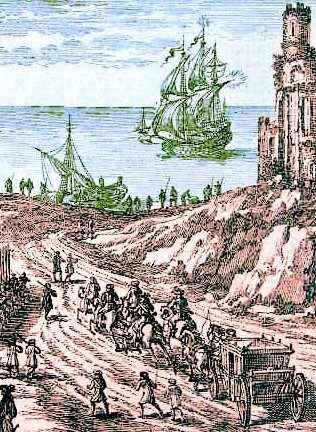
Meeting the Ship, From Description de l'univers, by Alain
Manesson Mallet (1683)
In the beginning, medicines depended largely on what surrounded the medical practitioner. The majority of medicines were plant-based, so local remedies were based on mostly in what grew and could be collected from the surrounding environment.
When the age of exploration began, awareness of foreign remedies increased and were incorporated into the materia medica (the body of collected knowledge about medicines). One of the primary things that led to the formation of the various East India companies in the seventeenth century was a desire to enter the spice trade. Spices were an integral part of medicines. Particularly prized in the beginning of overseas trade were Mediterranean herbs, drugs and opium.1 By the golden age of piracy, such exotics had become part of the pharmacopoeias and dispensatories.
Of course, sea surgeons were in a unique position with regard to foreign remedies; they were traveling to places where some of the medicines were grown and could be obtained easily. Their travels also exposed them to various local remedies during stops, allowing them to experiment. Some of the more adventurous sea surgeons even "went native", trying some of the exotic medicinals used by the native Caribbeans.
1 "Spice trade", wikipedia, gathered 4/12/15
Obtaining Medicines: Local Simples
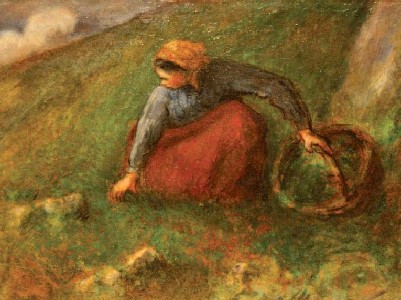
Artist: Camille Pissarro - Woman Gathering Herbs (1880)
Gathering and picking the simples or raw herbs required in medicine was an important part of the drug-making process, so it was part of apothecary's expertise (and, by extension, the physician working with the apothecary).1 Many of the local simples were either collected by herb women or the apothecaries themselves.2 "The London Society of Apothecaries required their apprentices to go 'asimpling' in the fields, and from the early seventeenth century appointed 'simpling days' and organized herbarising expeditions."3
Physic gardens containing organized plots of plants used in medicine were created just before the golden age of piracy. Their purpose was not so much for the production and harvesting of medicinal plants, but to provide apprentice apothecaries and physicians a place where they could learn about the plants.
The first 'official' physic garden to be established in England was University of Oxford Botanic Garden from an endowment by Sir Henry Danvers to create "a
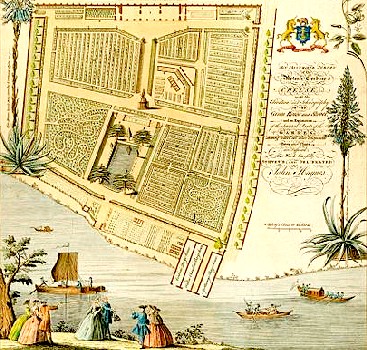
Artist: John Haynes
The Chelsea Physic Garden Plan View, Created to Grow Medicinal Herbs
By
The Worshipful Society of Apothecaries in 1673, Wellcome (1751)
physic garden for 'the glorification of God and for the furtherance of learning'"4 in 1621.
The Worshipful Society of Apothecaries created the second 'official' physics garden - Apothecaries' Garden (today called the Chelsea Physic Garden) - in 1673 "with the purpose of training apprentices in identifying plants."5 Sue Mintner, Curator of the Chelsea Physic Garden from 1991 to 2001, explains that the garden was a location from which
the Society could conduct 'herborizing' expeditions to adjacent sites such as Battersea or Putney Heath for the botanical instruction of their apprentices. Increasingly it provided a site for the growing of plants used in medicines for correct identification by the Society's apprentices. So it was a Garden above all for training.6
Illustrated herbal books and herbariums - collections of dried specimens - were important for identifying plants when apothecaries were 'asimpling.' They also allowed knowledge to codified and passed on so that the medical men could "assert their pre-eminence over oral, popular knowledge and the unlearned."7
1 Andrew Wear, Knowledge & Practice in English Medicine, 1550-1680, p. 65; 2 R.S. Roberts, “The Early History of the Import of Drugs into Britain”, From The Evolution of Pharmacy in Britain, Edited by F.N.L. Poynter, 1965, pp. 166; 3 Wear, p. 62; 4 "History of the Botanic Garden", botanic-garden.ox.ac.uk, gathered 4/13/15; 5 "History of the Garden", chelseaphysicgarden.co.uk, gathered 4/13/15; 6 Sue Minter, "Introduction", The Apothecaries' Garden: A History of the Chelsea Physic Garden, 2006, not paginated; 7 Wear, p. 65
Obtaining Medicines: Local Simples - Gathering and Processing
A greater concern to the apothecary and physician was when and how the simple plants and herbs should be gathered and processed. "The efficacy and goodness of the herbs that were used in remedies were a constant source of concern"1. A variety of factors were considered important including where and when the plant was harvested, how long it had been kept and how the intrinsic properties of different types of plants affected their potency.
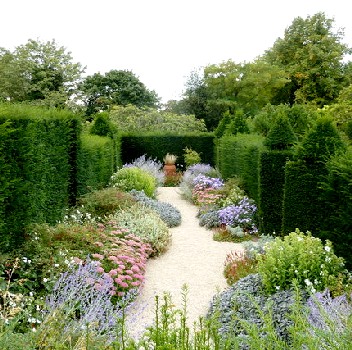
Photo: Pam Fray
Part of the Garden at late 17th Century Fenton House
in
Hampstead geograph.org.uk
The location where a plant grew was discussed at length in period dispensatories. Physician Jean de Renou warned against gathering plants from places that were "hollow, and polluted with dung, clay, and other naughty vapours... [as well as those which were] not free, but iniquinated [polluted], as the suburban Gardens, which smell more of smoke and dung than earth." He suggested that plants grown in such places "do not acquire the property due to their kinde and nature, but to [that of] the mixture of dung, and other things; and therefore Melons, Lettices, and other herbs growing in such putrid places, are more unwholesome”2.
Instead, de Renou recommended that his readers chose places "free from all strong smelling inquinations [pollutants]". Proper locations allowed a plant to "acquire the property due and convenient to their nature, while by an attractive faculty they draw the humour familiar to them out of the earth, and convert it to their nutriment; as those that are nourished with sweet, attract sweet humours; bitter, bitter humours; and such as are nourished by salt and nitrous humours, attract salt and nitrous humours."3 You will note that his reasoning has a humoral basis; plants, like people, were felt to have humors (which are essentially fluids) in their makeup.
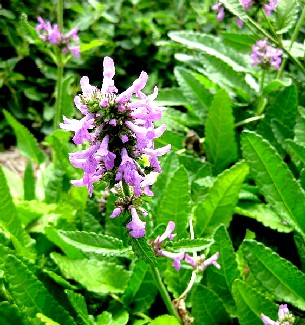
Wood Betony (Stachys officinalis) - gardenology.org
Fellow physician Nicholas Culpeper comments on location as well, although his advice is short and sweet by comparison, as well as being rather pragmatic. "Note in what place they [plants] must delight to grow in, and gather them there, for Betony that grows in the shadow, is far better that which grows in the Sun, because it delights in the shadow: so also such Herbs as delight to grow near the water let such be gathered as grow near the water, though happily you may find some of them upon dry ground”4.
Other location-based factors considered by period dispensatory authors included the time of day and weather in which a plant should be gathered. Culpeper says with regard to "the time of the day, let it be when the Sun shines upon that that so they may be dry, for if you gather either Flowers or Herbs when they are wet or dewy, they will not keep."5 Renou suggests following the advice of 1st century Greek Physician Pedanis Dioscorides by gathering medicaments "when the heavens are clear."6
The potency of herbs was thought to be affected by factors inherent in the plant. Renou explains that "all medicaments consisting of a thin and rare substance, and all such as abound in much humidity, continue but a short time efficacious: but those that are gross and solid, and less humid, endure longer, because their virtue cannot so easily exolve ['unbind'] and perish.”7
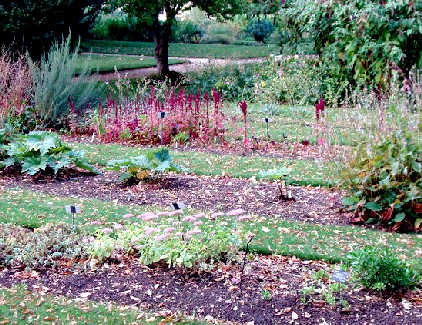
Photo: Dan Hawgood
Order Beds at the Oxford University Botanical Gardens, The Oldest
Physic Garden in England, geograph.org.uk
Plant potency was also linked to the goodness of the parts of the plant being used to make medicines. Of a plant's leaves, stalks and flowers, Renou advised that a plant's "stalks are to be gathered when they are perfect; leaves and flowers before they fall of themselves, for then for the most part they are perfect.”8
Nicholas Culpeper recommended the gatherer "chuse only such [leaves] as are green, and full of juyce, pick them carefully, and cast away such as are any way declining, for they will putrifie the rest, so shall one handful be worth ten of those you buy in Cheapside.”9
Like Renou, apothecary John Quincy advised his readers collect flowers "when they are full blown, and ready to shed"10. He also warned that when flowers lost "their Scent and Colours they lose in a great measure their [medicinal] Virtues"11.
Quincy recommended gathering seeds just before they fell from their plants.12 Culpeper agrees. "Let them be full ripe when they are gathered"13.
Fruits were universally agreed to be best when they were ripe14, "unless such whose Efficacy in Medicine depends upon the austerity [harshness] of their Juices; and such not quite ripe, are the better."15
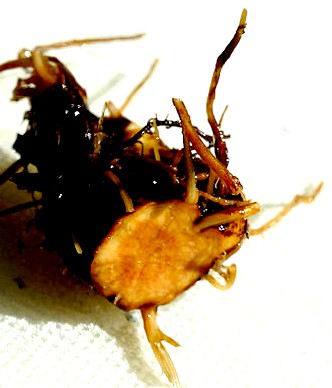
Photo: Wolfgang Frisch - Tormentil Root
Plant roots were an important part of period medicinals, although advice on gathering them varied. Quincy advised, "Roots are best taken up in the beginning of Spring, for Reasons obvious to all."16
Culpeper disagrees. He complains that some people believe that "the Sap falls down into the Root in the Autumn, and rises again in the spring, as men go to bed at night, and rise in the morning." He reasons that if this were true the root should grow in the winter, but "you shal find the Root to grow to a pretty bigness in that Summer, and be not a whit bigger next Spring; What doth the sap do in the Root all that while, pick straws?" Never one to mince words, Culpeper says, "For God's sake, build not your Faith upon Tradition, 'tis as rotten and a rotten post." Instead, recommends, "The drier time you gather your Roots in, the better they are: for they have the less excrementitious [cast out] moisture in them."17
Culpeper gives another bit of advice on root selection, telling his readers to "chuse such as are neither rotten, nor worm-eaten, but proper in their tast, color, and smell; such as exceed neither in nor hardness."18
Barks were also used in physic - Culpeper identifies three types: those removed from Fruits
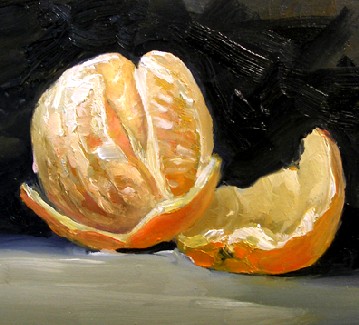
Artist: David Fairrington - Orange, Bark and Juice
(such as orange and lemon rinds), those from roots of herbs with pith in them (a bark he admits is 'something improperly' named) and those taken from boughs (or tree barks as we'd call them).
The fruit rinds were to be removed from the fruit when it was ripe. Root barks were to obtained by slitting the herb root and removing the pith. Tree barks were "best gathered in Spring, if it be of great Trees, as Oaks, or the like, because then they come easiest off"19. Here again we see Culpeper's practical side.
Although gums and juices are actually processed and not raw plants, our period authors had suggestions about the plants used to create gums and juices.
Culpeper recommends that juices "be pressed out of Herbs when they are young and tender, and also out of some Stalks, and tender tops of Herbs and Plants, and also out of some Flowers.”20 Renou advises that a gum "be drawn and pressed out of the stalks gathered while it is fresh, in the beginning of the Spring; or beginning of Summer, while the juice ascends into the stalk."21
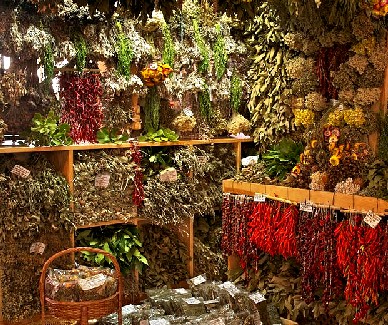
Photo: Alexander Baxevanis
Dried Spices & Herbs, Mercado dos Lavradores, Funchal Portugal
Drying medicinal plants was another factor in their potency which sometimes depended upon the nature of the plant. Culpeper explained, "Such Herbs as are well dried; will keep longer than such as are ill dried."22
For flowers, John Quincy explained that they "better dryd in the Sun than the Shade; for the quicker they dry, the better they preserve their Scent and Colour: whereas the Heat of the Sun will destroy the bright Green of many Plants."23
Culpeper suggested after seeds were gathered, "dry them a little, and but a little in the Sun before you lay them up."24
When drying roots, Culpeper explained that the proper drying procedure depended on the type of root. For soft roots "your best way is to dry in the Sun, or else hang them in the Chimney corner upon a string"25. For hard roots, "you may dry them any where."26 When drying barks, Quincy suggested that they "are best for being fresh dry'd"27, while Culpeper said you "may dry them if you please: but indeed your best way is to gather all Barks only for present use."28
1 Andrew Wear, Knowledge & Practice in English Medicine, 1550-1680, p. 65; 2,3 Jean de Renou, A Medicinal Dispensatory, 1657,pp. 43; 4,5 Nicholas Culpeper, The English Physitian Enlarged, 1666, p. 272; 6,7,8 de Renou, p. 41; 9 Culpeper, p. 271; 10,11,12 John Quincy, Pharmacopoeia Officinalis & Extemporanea, 1719, p. 66; 13 Culpeper, p. 272; 14 See Quincy, p. 66 & de Renou, p. 41; 15,16 Quincy, p. 66; 17 Culpeper, p. 273; 18 Culpeper, p. 272; 19 Culpeper, p. 273-4; 20 Culpeper, p. 274; ,21 de Renou, p. 41; 22 Culpeper, p. 272; 23 Quincy, p. 66; 24 Culpeper, p. 272; 25,26 Culpeper, p. 273; 27 Quincy, p. 66; 28 Culpeper, p. 274
Obtaining Medicines: Foreign Simples
With the age of exploration, foreign drugs became more accessible to European markets and found a place in the golden age of piracy era herbals, pharmacopoeias and dispensatories. Although sea surgeons had greater access to foreign remedies, their understanding of them was limited to their understanding of which medicines were useful for the medical problems they encountered. So medicinal books and training were crucial to how widely they used foreign remedies.
Andrew Wear says that the new remedies quickly found their way into the English medical system, where physicians "did not hesitate to recommend them: they believed that they could be used in Europe despite coming from different continents."1
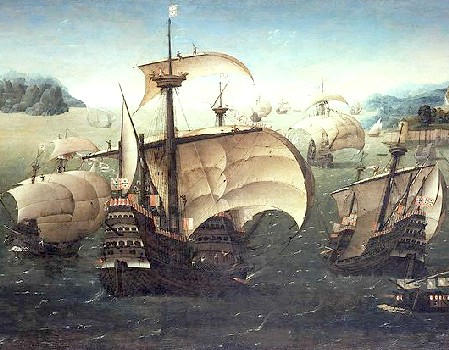
Artist: Circle of Joachim Patinir -
Portuguese Carracks Off a Rocky Coast (1540)
Medicinal spices came from all over the known world. While over-land trade routes had existed with eastern nations since the Neolithic era, the spice trade changed dramatically with long-distance sea voyages.2
Captain Vasco de Gama opened the sea route to India in 1497-1499 allowing the Portuguese crown to establish a trade monopoly with them. By the late 16th century, the Dutch and English were encroaching on this monopoly with the establishment of the Dutch East India and East India trading companies, allowing for greater distribution of overseas spices in northern Europe.
The spices were wanted as more for their ability to season food than anything.3 The herbs used to create drugs were "were an insignificant part (roughly l-2 per cent) of the total imports. The trade was mainly in the hands of East India merchants for whom the consignments of drugs were but sidelines to make up cargoes.”4 Even so, the drug trade with the Indies was significant to British medicine. R. S. Roberts reports that "in 1588 only 14 per cent of drugs had come directly from outside Europe, but by 1621 this proportion had risen to 48 per cent. By 1669 it was to reach 70 per cent, the greater part of which came from India and the East Indies.”5
Foreign drugs were brought into England by importers who were often referred to as 'pepperers' and wholesaling spicers. "Most of these traders were Italians based in London and they formed the nucleus of those trading fraternities which coalesced in the fourteenth century to form the Grocers Company of London [one of the forerunners of the Worshipful Society of Apothecaries active during the golden age of piracy].”6
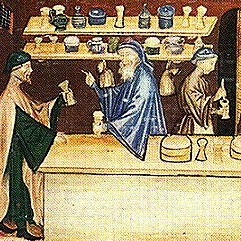
Making Theriac, From Tacuinum Sanitatis (14th c.)
Another reason for physicians to import foreign drugs from the Indies and Mediterranean was so that they could more accurately make up some of the ancient medicines recommended in the books of foreign surgeons which were still held in high esteem by many authors.
Andrew Wear explains that in 1540 theriac (a compound anti-venom used by some of our sea surgeons) contained twenty substitute ingredients. "But by 1566 Francesco Calzolari, the Veronese botanist-pharmacist, claimed that he only needed to use three substitutes, and in 1568 Mattioli declared that the theriac of the present age was as good as that mixed by Galen for the emperors."7 Similarly, the popularity of the Arabic panaceas created a need for foreign ingredients like scammony and colocynth "which were more drastic in their action than the commoner European herbs.”8
_1552s.jpg)
Artist: Martin de la Cruz
Sanguinaria herba (blood herb) from Libellus de
Medicinalibus Indorum Herbis (1551) New World medicinals were a slightly different matter. When Columbus stumbled across the Caribbean in his search for a new route, the Spaniards expected the newly discovered lands to provide new medicines in addition to other rare commodities.
Find them they did. In 1552, Aztec physician Martin de la Cruz's book Libellus de Medicinalibus Indorum Herbis was translated into Latin and sent to Spain. It contained 'hundreds of medicinal plants'9. As a result of this and reports coming back from the new world, King Philip II directed protomedico (public health officer) Francisco Hernandez to gather information on 'herbs, trees and medical plants' that grew in New America "to learn how precisely they could be used as medicines."10
When the English made their way to the Americas, "they were very well aware that remedies from the new-found lands were valuable commodities."11
1 Andrew Wear, Knowledge & Practice in English Medicine, 1550-1680, p. 72; 2 "Spice trade", wikipedia, gathered 4/14/15; 3 R.S. Roberts, “The Early History of the Import of Drugs into Britain”, From The Evolution of Pharmacy in Britain, Edited by F.N.L. Poynter, 1965, p. 166; 4 Roberts, p. 171; 5 Roberts, p. 170; 6 Roberts, p. 166; 7 Wear, p. 68; 8 Roberts, p. 166 9 Wear, Footnote 58,, p. 69; 10 Wear, p. 69; 11 Wear, p. 70;
Obtaining Medicines: Foreign Simples - Syphilis & Guaiacum
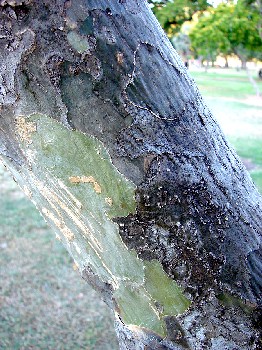
Photo: Forest & Kim Starr
Guaiac Wood - Guaiacum Officinale
Another factor driving interest in foreign remedies was the ability to treat 'new' diseases not covered in the classical medical books. R. S. Roberts explains how syphilis, which appeared in the late 15th century, caused physicians to experiment with exotic remedies to try and find a cure. "The most popular of these was guaiacum which, coming from the supposed venue of syphilis itself, was thought to be the most suitable on the principle that God had given a local remedy for all diseases.”1 Since syphilis (often called 'the Pox' at this time) was believed by many to have come from the New World and guaia wood also came from the New World and was used with apparent good results by Native Americans as a treatment2, it should be effective against the disease.
English physician William Bullein trumpeted this remedy in his 1562-3 Boke of Simples, noting that in the Americas the natives "make a decoction of the wood or barkes of the same which bringeth... health, the Spaniard preserving the same, did bring this woode into Europe, not only for to heale their owne Pox, but also for Fraunce, Italy, Germany and for England in whome this woodde taketh no small effecte for the forsaide Pox."3
The Spanish were not quite as benevolent as Bullein suggests. The import of guaiac made a lot of money for them. As Wear states, "Remedies were often associated with money, and the more novel and exotic a remedy, the more profitable it was likely to be."4
1 R.S. Roberts, “The Early History of the Import of Drugs into Britain”, From The Evolution of Pharmacy in Britain, Edited by F.N.L. Poynter, 1965, p. 169; 2 Andrew Wear, Knowledge & Practice in English Medicine, 1550-1680, p. 69; 3 Wear, p. 79; 4 Wear, p. 69

